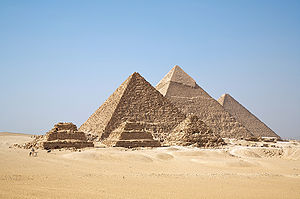Book of the Dead

The "Book of the Dead" is the usual name given to the ancient Egyptian funerary text called the "Spells of Coming (or Going) Forth By Day." The Book of the Dead was intended to assist the deceased in the afterlife and comprised a collection of hymns, spells and instructions to allow the deceased to pass through obstacles in the afterlife. The Book of the Dead was most commonly written on a papyrus scroll and placed in the coffin or burial chamber of the deceased.[2]
| Part of a series on |
| Ancient Egyptian religion |
|---|
 |
| Main beliefs |
| Mythology · Soul · Duat · Ma'at Numerology |
| Practices |
| Offering formula · Funerals |
| Deities |
| Amun · Amunet · Anubis · Anuket Apep · Apis · Aten · Atum · Bastet Bat · Bes · Four sons of Horus Geb · Hapy · Hathor · Heka · Heqet Horus · Isis · Khepri · Khnum Khonsu · Kuk · Maahes · Ma'at Mafdet · Menhit · Meretseger Meskhenet · Monthu · Min · Mnevis Mut · Neith · Nekhbet · Nephthys Nu · Nut · Osiris · Pakhet · Ptah Qebui · Ra · Ra-Horakhty · Reshep Satis · Sekhmet · Seker · Selket Sobek · Sopdu · Set · Seshat · Shu Tatenen · Taweret · Tefnut · Thoth Wadjet · Wadj-wer · Wepwawet Wosret |
| Texts |
| Amduat · Books of Breathing Book of Caverns · Book of the Dead Book of the Earth · Book of Gates Book of the Netherworld |
| Related topics |
| Atenism · Curse of the Pharaohs |
|
Ancient Egypt portal |
The Book of the Dead was the product of a long process of evolution starting with the Pyramid Texts of the Old Kingdom through the Coffin Texts of the Middle Kingdom. About one third of the chapters in the Book of the Dead are derived from the earlier Coffin Texts.[3] The Book of the Dead itself was adapted into The Book of Breathings in the Late Period, but remained popular in its own right until the Roman period.
Contents |
Egyptian name
The name for the book in the Egyptian language was rw nw prt m hrw. This derives from the title of one of the most important spells, Spell 17, prt m hrw.[4]
Rw is the plural of r, meaning 'mouth'. R can also refer to a thing said, such as a piece of speech or, in this case, a ritual incantation.
Nw is a form of n, meaning 'of'. This 'genitival adjective' grammatically agrees with the preceding noun. Nw is the masculine dual/plural form.
Prt is an action-noun derived from the verb prj, meaning 'emerge', 'arise'. It denotes the act of emerging or arising.
M is a preposition typically meaning 'in'. When dealing with time, it can mean 'during'.
Hrw means 'day', 'daytime'.
Thus a literal translation is 'utterances of emergence during daytime'. A slightly looser translation for sense could be 'spells of going out in the daytime'.
The use of the word "rw" to describe the texts indicates that the intention was that they were spoken out loud or recited. For this reason some Egyptologists call the sections 'spells' while others use the more neutral term 'chapters'.
Versions
Single spells of the Book of the Dead are already known from the late Middle Kingdom. Many spells on the coffins of Sesenebnef or queen Mentuhotep are identical to later chapters of the Book of the Dead. During the New Kingdom The Book of the Dead was not organized or standardized in a set order. The texts appear to reflect the preferences of the individual or their family. This is known as the 'Theban Recension'. In the Third Intermediate Period leading to the Saite period, the Book of the Dead became increasingly standardized and organized into a set number of Spells or Chapters in a standard order and versions of this period are known as the 'Saite Recension'.
Saite recension
The Books of the Dead from the Saite period tend to organize the Chapters into four sections:
- Chapters 1–16 The deceased enters the tomb, descends to the underworld, and the body regains its powers of movement and speech.
- Chapters 17–63 Explanation of the mythic origin of the gods and places, the deceased are made to live again so that they may arise, reborn, with the morning sun.
- Chapters 64–129 The deceased travels across the sky in the sun ark as one of the blessed dead. In the evening, the deceased travels to the underworld to appear before Osiris.
- Chapters 130–189 Having been vindicated, the deceased assumes power in the universe as one of the gods. This section also includes assorted chapters on protective amulets, provision of food, and important places.[3] There are 192 unique chapters known, and no single papyrus contains all known chapters.
Production


Books were often prefabricated in funerary workshops, with spaces being left for the name of the deceased to be written in later. They are often the work of several different scribes and artists whose work was literally pasted together. The cost of a typical book might be equivalent to half a year's salary of a laborer, so the purchase would be planned well in advance of the person's death. The blank papyrus used for the scroll often constituted the major cost of the work, so papyrus was often reused.[3]
Images, or vignettes to illustrate the text, were considered mandatory. The images were so important that often the text is truncated to fit the space available under the image. Whereas the quality of the miniatures is usually done at a high level, the quality of the text is often very bad. Scribes often misspelled or omitted words and inserted the wrong text under the images.
Publication history
The name "Book of the Dead" was the invention of the German Egyptologist Karl Richard Lepsius, who published a selection of the texts in 1842. When it was first discovered, the Book of the Dead was thought to be an ancient Egyptian Bible. But unlike the Bible, the Book of the Dead does not set forth religious tenets and was not considered by the ancient Egyptians to be the product of divine revelation, which allowed the content of the Book of the Dead to change over time.
The earliest manuscripts were published in the aftermath of the Egyptian expedition led by Napoleon Bonaparte in Description de l'Ėgypte (1821). Jean Francois Champollion was one of the early translators. In 1842 Karl Richard Lepsius published a version dated to the Ptolomaic era and coined the name "Book of The Dead", a title not known or used by the Ancient Egyptians, as well as the chapter numbering system which is still in use. Samuel Birch published the first English version in 1867. Edouard Naville published what was to become the first full standard edition in three volumes (1886). Using the papyrus texts in the British Museum E. A. Wallis Budge published editions including the Papyrus of Ani, which Naville had not dealt with, in 1890. Peter le Page Renouf's English edition was published in parts beginning in 1892. Budge's hieroglyphic edition was published in 1898 and is still widely used. Budge's 1901 English translation is still in print. More recent translations in English have been published by T. G. Allen (1974) and Raymond O. Faulkner (1972).[5]
See also
- Aaru
- Bardo Thodol (Tibetan book of the dead)
- Ghosts in ancient Egyptian culture
References
- ↑ The Hall of Maat at egyptartsite.com
- ↑ Caroline Seawright The Book of the Dead at TourEgypt
- ↑ 3.0 3.1 3.2 Goelet, Ogden (1998). A Commentary on the Corpus of Literature and Tradition which constitutes the Book of Going Forth By Day. San Francisco: Chronicle Books. pp. 139–170.
- ↑ Allen, James P., Middle Egyptian - An Introduction to the Language and Culture of Hieroglyphs, first edition, Cambridge University Press, 2000. ISBN 0-521-77483-7
- ↑ "The Ancient Egyptian books of the Afterlife", Erik Hornung, translated by David Lorton, p15-16, Cornell University Press, 1999, ISBN 0801485150
Further reading
- Thomas George Allen, The Egyptian Book of the Dead: Documents in the Oriental Institute Museum at the University of Chicago, Thomas George Allen, (University of Chicago Press, Chicago), c 1960.
- Thomas George Allen, The Book of the Dead or Going Forth by Day. Ideas of the Ancient Egyptians Concerning the Hereafter as Expressed in Their Own Terms, Thomas George Allen, (SAOC vol. 37; University of Chicago Press, Chicago), c 1974.
- E. A. Wallis Budge, The Egyptian Book of the Dead,(The Papyrus of Ani), Egyptian Text, Transliteration, and Translation, E.A.Wallis Budge, (Dover (Note: 240 pages of running hieroglyphic text. NB: Budge's translations and transliterations are extremely outdated and are not generally cited by modern Egyptologists)
- Raymond O. Faulkner, The Ancient Egyptian Book of the Dead, translated by Raymond Faulkner, edited by Carol Andrews (University of Texas Press, Austin), c 1972.
- Raymond O. Faulkner, The Egyptian Book of the Dead, The Book of Going forth by Day. The First Authentic Presentation of the Complete Papyrus of Ani translated by Raymond Faulkner, edited by Eva von Dassow, with contributions by Carol Andrews and Ogden Goelet (Chronicle Books, San Francisco), c 1994.
- Gunther Lapp, The Papyrus of Nu (Catalogue of Books of the Dead in the British Museum), by Gunther Lapp, (British Museum Press, London), c 1997.
- Andrzej Niwinski, Studies on the Illustrated Theban Funerary Papyri of the 11th and 10th Centuries B.C., by Andrzej Niwinski, (OBO vol. 86; Universitätsverlag, Freiburg), c 1989.
- Kolpaktchy, Gregoire. Le Livre des Morts des Anciens Egyptiens. (France, 1954)
- Kolpaktchy, Gregoire. Das Agyptische Totenbuch. (Switzerland, 1954)
External links
- Egyptian Book of the Dead
- Budge, E. A. Wallis, "Book of the Dead, The Papyrus of Ani".
- Online Readable Text, with several images and reproductions of Egyptian papyri
- Papyrus of Ani complete, in one scrollable image.
- Papyrus of Hunefer With many scenes and their formula English translations, from the copy now in the British Museum.
|
|||||||
